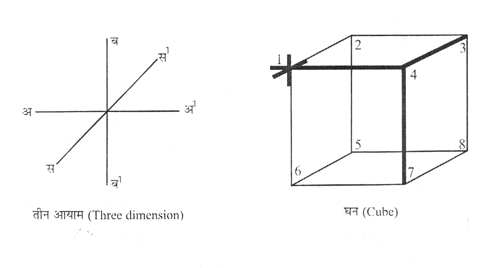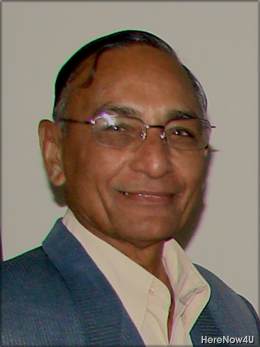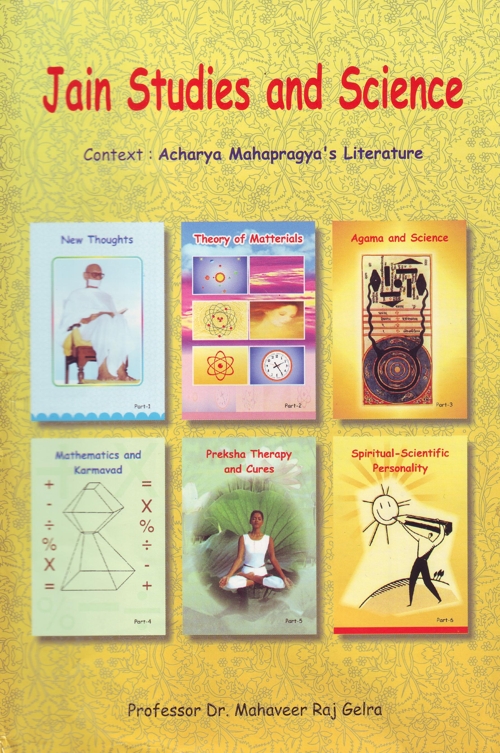In Jain metaphysical theories of kaal, two hypotheses are prevalent -
1. In Digamber thought, time is considered an independent and separate entity.
- Time is atomic.
- Time-atom is associated with every co-ordinate of space.
- Time is uni-dimensional unlike space which is three-dimensional.
2. In Shwetamber school of thought, time is just an aspect or epithet of jiva-ajiva entities.
- 'Time' starts every time a change takes place. Any happening or event, as and when it takes place, does not happen with prior space-time calculations, but an observer needs space-time dimensions to describe it.
- Imagine a situation where a stone is lying on a rock. There is no movement and everything is static. For an observer there is nothing to describe. In other words, there is no need of time. But, the moment stone moves, due to any reason, time starts. Now, the observer need the time-moment of movement (present), the time-duration of rest before movement (past) and the time-prediction of movement to remain continued (future). The moment of change thus becomes the reference of time measurement. This reference is 'present', and can be described fully along with past and future.
Mahapragya has harmonised both the concepts. According to him, both the statements are complementary to each other and not contradicting. With the help of Anekant view-point, he states that since time has duration, quantization, priority and posteriori - Digamber view holds, but since time acts only upon an entity undergoing change - Shwetamber view holds. He further states that both schools of thought agree that the time is not spatially extended substance (astikaaya).
Outlook of ScienceThe turning point in the perception of time was Einstein's special theory of relativity which later developed into general theory of relativity.
Before -Time was considered as absolute and completely independent of space. For example, a train running at 60 km/hr with respect to a stationary observer will appear to be running at 40km/hr to an observer moving at 20km/hr in same direction and at 80km/hr to an observer moving at 20km/hr in opposite direction. Similarly, it was believed that the speed of light (by means of which we observe) will have different measures for observers moving at different speeds in different directions.
After -Speed of light is considered absolute now, which means speed of light will be measured to be the same (3xl08 metre/second) irrespective of speeds and directions of different observers. This was proved by Michelson-Morley. This singular observation changed the concept of time once and for all - from being absolute to being relative. Science has put a limit to the speed of any object as less than or equal to that of speed of light. According to Einstein's equation of E=mc2 only nearly massless particles can attain speed of light with negligible energy. Even slightest mass in the particle will require enormous energy to move at the speed of light because the value of'c' is very high (3xl08 metre/second).
According to Einstein, space and time together create a static screen or frame. This means that any event can be described in terms of three space and one time co-ordinate. When such a four co-ordinate description is given, the inherent to it is a zero position with reference to which the co-ordinates are measured. In case of time, since the observer constantly adjusts the zero to the 'Present', two directions of past and future are created. This is similar to having positive and negative x, y and z axes. Omniscience is all about knowing the absolute zero co-ordinates of time and space, the great theoretical physicist Professor Hawking calls it 'Singularity'. Mahapragya states that we have divided time in three parts or periods - past, present and future but time is indivisible or eternal if perceived from absolute zero position. All these three great personalities, while describing the ultimate knowledge (Keval Gyan), agree to the fact that time can be accessed both ways provided the 'speed of perception' breaks the barrier of speed of light.
Keval Gyan -Omniscience is a well accepted Jain doctrine. Omniscient spirit is believed to possess infinite, complete and pure knowledge. The knowledge of Keval Gyani transcends all barriers of time, space, matter and energy. His knowledge is spiritual and not sensory. Arhats know entire lok and Alok, i.e. the universe, mattereals (dravya) and all their properties.
A perplexing question, therefore, always arises. How is it that an Arhat, a human being, knows the entirety as this involves knowing past, present and future simultaneously?
Great Jain saint Mahapragya has effortlessly resolved this dilemma. According to him, Arhat does not access the happenings sequentially as we do. While the speed of light is our limit of perception, HE has the capacity to deploy his perceptive sukshma-pudgals (mass-less micro particles like dions and quadons) to captures the entire sequence with infinite speed. Period of capture reduces to zero so that the time elapsed cannot be quantified and entire happening collapses into a zero-period frame. This is supported by modern scientific and mathematical advancements also.
We find everything in pairs - lok & Alok, positive & negative, matter & anti-matter, so does zero and infinity - they too, form an inseparable pair. Try adding miniscule to infinity we get zero or try subtracting something from zero, we get infinity. The tangible world exists between these two extremes. It is much significant that any unit when tends to become infinite another unit associated with it spontaneously becomes zero.
Mathematically, any arithmetic digit, if divided by zero, the result obtained is infinite. For example, x/0 = ∞.
Stating same thing in terms of physics, if mass attains infinite density, the space occupied reduces to zero. Similarly,
Time = distance / speed
When speed ->∞, time -> 0, irrespective of distance involved. Here lies the entire explanation of the phenomenon of omniscience. In Jain philosophy, the distance is synonymous to the knowledge. In case of nirvana, when speed = ∞ and time = 0, applying above formula,
Knowledge = infinite speed x zero time
Interestingly, the resultant outcome of this equation is indefinite and could be either ∞ or 0. While the first result of ∞ stands for an Arhat, the second outcome of 0 exemplifies moksha or emancipation of the spirit. A simple analogy explains it better - take a circle, and imagine its diameter increasing till it becomes infinite. It remains a circle till its diameter is just short of infinity, after which, at infinity, it is no more a circle, but a straight line with infinite extent - state of Arhat. Conversely, reduce the diameter, till it becomes zero. Circle may become a point with infinitesimally small diameter, but when diameter actually becomes zero, strangely, everything disappears - moksha.
This also convincingly explains that how Arhats possess the entire knowledge of past, present and future.
Mahapragya proclaims that Keval-Gyanis with their infinite extent of space and infinite speed, acquire the mechanism to convert the seemingly moving time into a static frame. For HIM therefore, time is only 'present' in which both 'past' and 'future' merge. This fusion of various divisions of time, actually results in the entire collapse of time - what remains is just 'the happening'. This definition of Mahapragya for one of the important terms - infinite knowledge of Jain literature is so marvellous that it reflects his genius.
Lord Mahavira, while propounding the Jain philosophy had experienced this possibility. The soul can achieve infinite speed if void of all attached karmas which limit the speed. Under such a unique and singular condition, time becomes zero. It can be easily understood by way an example-Example:
- We all know that the light rays take approximately seven minutes to reach the earth from the sun. This means that what we presently see on earth is actually seven minute old past of the sun.
- Imagine an observer (Keval Gyani) with a capacity to attain infinite speed, by virtue of which HE can be present at both the places (earth and sun) simultaneously.
- At any given moment, while HE is observing a ray of light 'presently' emanating from the sun, HE is also observing the seven minute hence 'future' of the earth. Similarly, what HE is observing as the light ray 'presently' on the earth was actually the seven minute old 'past' of the sun.
- Again, imagine HIS infinite speed and HIS presence at the sun's centre. HE is therefore present at all the three places (earth, sun and centre of the sun) simultaneously.
- At any moment let us presume that the stock of gases is exhausted and fission/fusion stops at the sun's centre. This 'present' of the sun's centre will become the future of sun's surface. So, HE knows the dark 'future' of sun's surface by knowing the 'present' of sun's centre. Extrapolating, by knowing 'present' of sun's surface HE knows the future of earth and past of sun's centre.
- Similarly, imagine HIS presence in the entire universe at any given single moment of time. Since Present of one is past of something and future of something else, HE is said to know all - the present, the past and the future.
- Therefore, the omnipresence (infinite speed of perception) of a Keval Gyani is the reason for HIS omniscience (infinite knowledge).
The smallest unit of time as available in Jain literature is 'Ek Samay', which is further indivisible. This unit is so small that innumerable Samay are said to elapse in a blink. Next practical unit of time is called Avalika. What is the significance of Samay and Avalika?
We have our time measurement in terms of earth's cycle around sun as 24 hours. Smaller units are called minutes and seconds. In modern science, time is now defined in terms of speed of light.
Mathematically models created by science can convert any happening of past in terms of present. Those who believe the relativity of time and space, have only perennial undivided time. Professor Hawking proposes that the real time moves only in forward direction but the imaginary time, which is non-directional, can move in backward direction. Mathematically, in imaginary time, any point of time in forward direction may be reversed in backward direction. Theoretically, any event of past can be known in present. Hence, the modern science supports the classic concept of Jains' infinite knowledge.

 Dr. Mahavir Raj Gelra
Dr. Mahavir Raj Gelra

